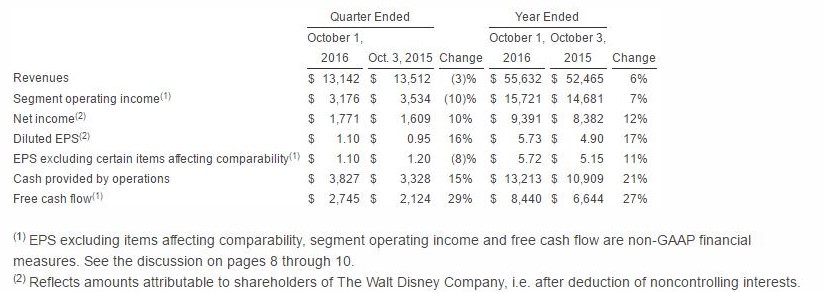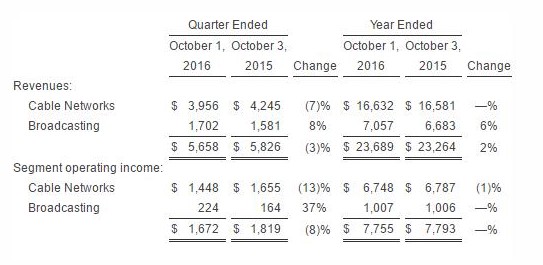Introduction
In early September I wrote an article speaking to the fact that The Walt Disney Company (NYSE:DIS) couldn’t seem to get out of its own way when it came to breaking out of its chronic stock slump. Over the past few weeks, Disney has seen a major move towards the $100 threshold after reporting its quarterly results and breaking the all-time worldwide box-office record. This uptick has been buoyed by Doctor Strange, Moana and Rouge One to round out the year at the box office. The stock fell from the $120s in late 2015 to low $90s and had been stuck in the $90 range all throughout 2016. This perpetual slump was almost entirely attributable to the decrease in ESPN subscribers and thus revenue and profit from their Media Networks segment. Excluding ESPN, Disney has been executing well and reporting record numbers throughout its other business segments. Disney has a deep and diversified enough entertainment portfolio to make a compelling case that these ESPN fears are overblown. Disney’s portfolio consists of Marvel Entertainment, Lucasfilm, Pixar, ESPN, ABC, 32% shareholder in Hulu and of course the core Disney franchise (Disney Studios, Disney consumer products, Parks and Resorts and Disney Cruise Line). The revenue stream from these assets is as diverse as the assets themselves. The ESPN franchise within the Media Networks segment generates revenue/operating income that are disproportionate to the amount of the company’s overall revenue and operating profit. Thus, one can see why investors were spooked after two consecutive significant declines in ESPN subscribers and thus numbers over the past three years. The decreases in revenue within this segment have been arrested and on the rebound due to measures put in place at Disney. As this revenue stream slowly recovers with initiatives put in place and investors can rest assure, Disney will likely retrace the $120 level seen in 2015.
Full-Year and Q4 2016 Record Results
Disney posted full-year and Q4 2016 earnings of $5.73 and $1.10 per share, respectively. Disney reported record full-year revenue, income and EPS of $55.6 billion, $9.4 billion and $5.73, respectively.
“We’re very pleased with our performance for the year, delivering the highest revenue, net income and earnings per share in Disney’s history” and “Fiscal 2016 was our sixth consecutive year of record results, highlighted by the opening of Shanghai Disney Resort, the phenomenally successful return of Star Wars, and our Studio’s record-breaking $7.5 billion in total box office. We remain confident that Disney will continue to deliver strong growth over the long-term as we further strengthen our brands and franchises, our technological capabilities, and our international presence.” Disney’s CEO
Quarter-over-quarter Disney saw double-digit increases in net income, EPS free cash flow despite revenue decreasing by 3%. On an annual basis, Disney saw a 6% increase in revenue, 17% increase in EPS and 27% increase in free cash flow (Figure 1).

Figure 1 – Quarterly and annual performance numbers
Disney Breaks Worldwide Box Office Record Again
With only 5 weeks remaining in 2016, Disney has already earned $5.81 billion in worldwide ticket sales as of November 1. Disney’s 2015 record of the worldwide total gross was at $5.84 billion, thanks in large part to Star Wars: The Force Awakens. Given the initial success of Doctor Strange and Moana, the $6 billion mark has already broken with Star Wars Rouge One rounding out 2016 pending release. Doctor Strange opened with an $85 million weekend debut while hauling in over $580 million worldwide as of November 24th. Moana hit theaters on November 23rd and registered $2.6 million on its opening Tuesday beating Frozen’s $1.2 million Tuesday debut in 2013. Moana is expected to score $80-$85 million over the Thanksgiving weekend. Star Wars Rogue One will hit theaters on Dec. 16.
Alan Horn through a press release wrote, “For the second year in a row, The Walt Disney Studios has reached a new high at the box office thanks to an absolutely stellar collection of releases from Disney, Disney Animation, Pixar, Marvel, and Lucasfilm.” He further noted, “This success is a testament to the refined talent and innovative work the entire Studio team puts into making these world-class cinematic experiences.”
Arresting The ESPN Mass Exodus
Disney announced that ESPN lost ~2 million subscribers in FY 2016, marking the lowest number of subscribers since 2005. ESPN subscribers fell by 2.2% to 90 million for the third straight annual decline albeit it’s the slowest rate of decline compared to 2015’s 3.2% slide to 92 million and 2014’s 4% fall to 95 million after peaking at 99 million in 2013. Disney has initiated corrective actions regarding the ESPN declines. Disney recently announced a deal with Hulu for live-TV streaming which will include ESPN live and other Disney/ABC features. Vice and Disney also set a production deal with ESPN that will see programming shared between the two companies. Disney is the largest stakeholder in Vice after putting $400 million into the company in addition to the piece it holds through its stake in A&E Networks. Disney announced that it is buying a 33% stake in BAMTech. This is intended to accelerate growth in direct-to-consumer video streaming. This will be a new ESPN-branded multi-sport direct-to-consumer service. BAMTech will be separated from Major League Baseball's (MLB) digital arm as part of the deal. Disney will pay $1 billion and has an option to acquire majority ownership in the future. Disney said that BAMTech will work with ESPN to launch a direct-to-consumer, subscription streaming service, featuring live sporting events at the regional, national and international levels. BAMTech will launch later this year and feature content already licensed from MLB and NHL. Current content on ESPN's linear networks will not be part of the service. Live TV, especially sports, remains one of the biggest viewership numbers for traditional television. ESPN’s decline has ostensibly slowed to the inflection point where other initiatives will begin to bear fruit and declines will be fully arrested. Assuming Disney can reenergize this segment with its ongoing partnerships and efforts, Disney will likely continue to move higher (Figure 2).

Figure 2 – Financial figures surrounding Disney’s media segment
Potential Tax Implications
There could be some major tax implications for Disney that will positively impact the business. On the earnings call, Iger stated that the media giant has pushed both the legislative and executive branches to lower the corporate tax rate. President-elect Trump and top congressional Republicans have supported a lower tax rate for corporations, specifically Trump has been a proponent of a 15 percent business tax rate. Iger stated that it is "too early to speculate" about how Trump's administration will affect Disney or business more broadly. However, he stated that a so far "smooth" transition of power bodes well. "That can only be good for business and for the country," Iger said. In 2015, Disney paid an effective tax rate of 46.0% however for 2016 it was lower at 34.4% due to the Disneyland Paris Tax Asset Write-off, which increased the effective tax rate by 12.4 percentage points in the prior-year quarter. Moving forward, if the corporate tax rate is decreased this will provide a windfall of money to potentially make more investments to drive growth, increase the dividend and share buybacks.
Conclusion
The Walt Disney Company (NYSE:DIS) reported great numbers across the board on an annual and quarterly basis. Disney is addressing its ESPN subscriber losses via deals and partnerships with Hulu, Sling, Vice and BAMTech. Disney has seen the Media Networks revenue and income stabilize over the last year with a 2% increase in revenue and unchanged income figures. Disney has a deep and diversified enough entertainment portfolio to make a compelling case that these ESPN fears are overblown even if stagnation is occurring. Disney’s portfolio consists of compelling asset mix such as Marvel Entertainment, Lucasfilm, Pixar, ESPN, ABC, a 32% shareholder in Hulu and the core Disney franchise (Disney Studios, Disney consumer products, Parks and Resorts and Disney Cruise Line). When the was trading around $92 with P/E ratio of ~16.0, I sold a secure put at a strike of $100 with an expiration of 20JAN17 for a premium $9.26 per share. If the stock appreciates beyond $100 per share prior to expiration, then I will have a realized gain of $926 or 9.3% without owning these shares for this specific trade. I purchased additional shares as part of my long-term core portfolio holdings.
Noah Kiedrowski
INO.com Contributor - Biotech
Disclosure: The author holds shares of DIS and is long DIS, the author holds a secured put contract on shares of Disney with a strike price of $100. The author has no business relationship with any companies mentioned in this article. He is not a professional financial advisor or tax professional. This article reflects his own opinions. This article is not intended to be a recommendation to buy or sell any stock or ETF mentioned. Kiedrowski is an individual investor who analyzes investment strategies and disseminates analyses. Kiedrowski encourages all investors to conduct their own research and due diligence prior to investing. Please feel free to comment and provide feedback, the author values all responses.


Hi All
As Disney broke through $104 today, I took the opposite position that Kevin pointed out with a secured put contract that has now paid off. I closed my contract for $1.00 as it shot through the strike price of $100 to net a gain of $8.18 per share or 8.2% return over the course of 7 weeks while still holding my long position.
Thanks for reading, Noah
This article was very useful
As always great
disney and viacom are the two to watch for delta positives re revenue and eps. nix fox and to lesser extent, tribune.
I appreciate the fundamental take, but let me play devil's advocate from a technical perspective. Disney is actually 22% from its highs, not pushing them. It's also moving up on light relative volume into previous high-volume down spikes and significant year-long horizontal resistance. Today, it also tagged to within one penny the 61.8% fib retracement of its swing high from May, 2016. That particular Fib retracement percentage often marks a near-immediate reversal. I'm actually tempted to short DIS here, not throw long.
Hi Kevin
Interesting perspective on the technical take, much appreciated. I look at the fundamental analyses coupled with high-level technicals. For Disney, the fundamentals are strong with the exception of the ESPN franchise which is addressed in the article coupled with the fact that the stock has sold off from the $120 level to the low $90 level and remained at that level for months. With the holiday season approaching and Star Wars hitting the big screen, I can't envision a situation in which Disney moves down to the $80 level. Looking at the P/E, it's cheaper than the average stock and I took the opposite bet and sold a secured put at a strike of $100 for January 2017. It's already broken the strike price and thus only time value remains. I'm currently waiting for the time value to evaporate so I can capture 90% of the option premium. Sold it for $9.26 and the current price is sub $2.00 so I took advantage of the massive sell-off to hopefully soon make a quick ~$900 in addition to my long position. I'd be cautious shorting a high-quality company when it's already sold off double-digits.